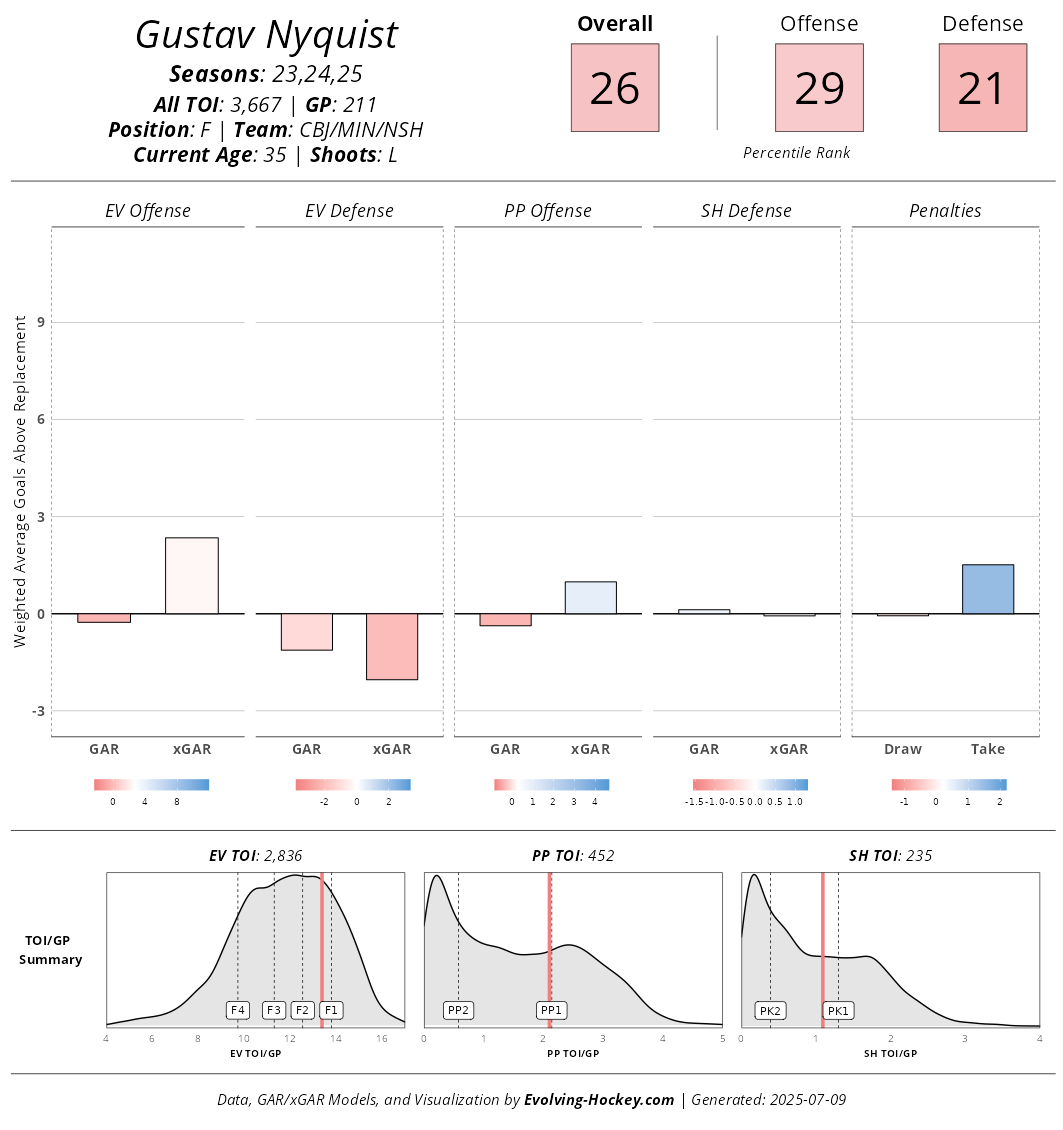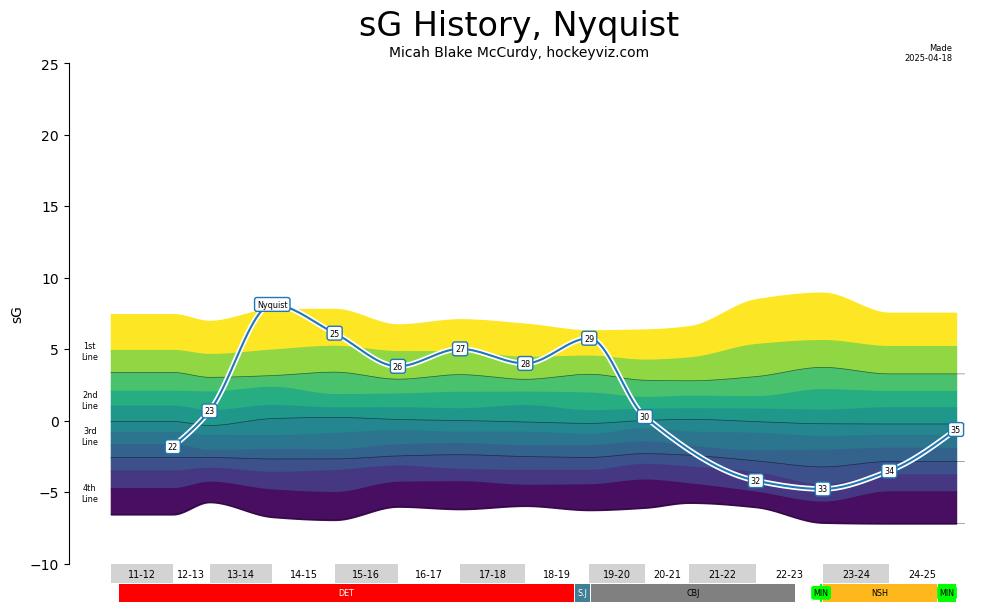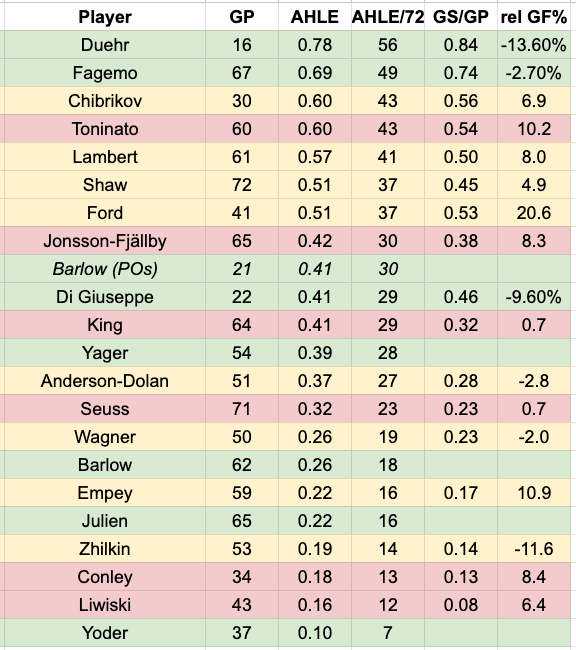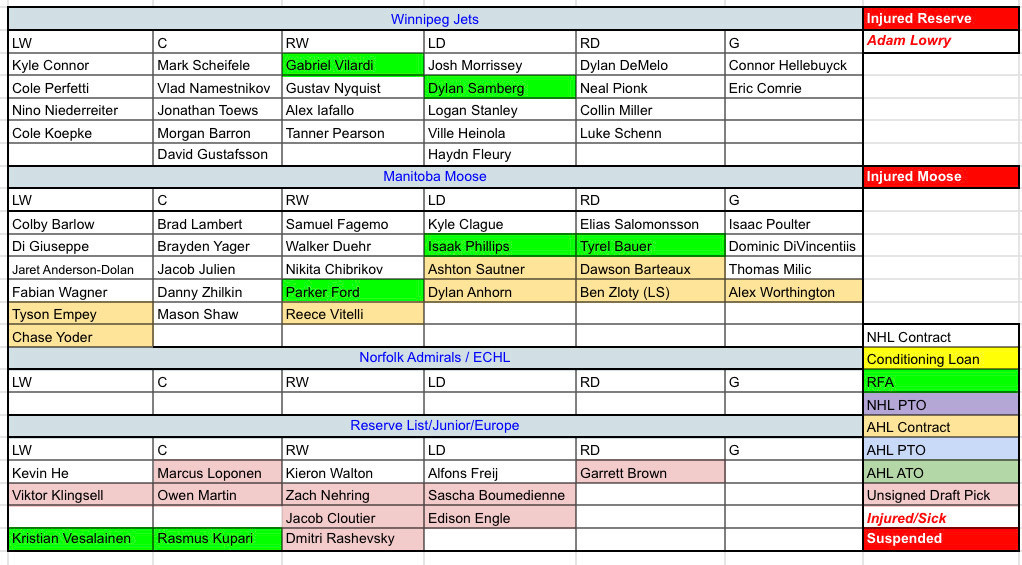An analytical profile of Gustav Nyquist, others, and how the Winnipeg Jets look post-free agency
Rumours swirled around the Winnipeg Jets being in on top UFA wingers Nikolaj Ehlers, Brock Boeser, and a few others that never quite made it to free agency.
The Jets ended up with Gustav Nyquist and a bunch of depth additions to the organization.
Let’s take a look at who they are and what this means for the Jets.
The summer series thus far
Winnipeg Jets 2024-25 Season and Playoffs Review
In our first post, I reviewed the Jets’ performance as a team in both the regular season and playoffs. I looked at team-level results and the general performance of the roster and its components.The case for and against Winnipeg Jets extending Nikolaj Ehlers
In our second post, I took a deep dive into Nikolaj Ehlers—Kevin Cheveldayoff’s biggest offseason question.Should the Winnipeg Jets actually sign Jonathan Toews
I then pivoted in our third post, covering some trending news: the idea of signing Jonathan Toews for the 2025–26 season, and what that might realistically look like.Which Winnipeg Jets’ free agents are worth keeping
I took a look at the value the Jets received from their free agents, how they project to perform, and made some suggestions on whether or not they’re worth keeping based on their impact.If I were Kevin Cheveldayoff… (Part 1: Needs)
I took stock of the team’s current strengths and weaknesses and began building a plan for maximizing Winnipeg’s contention window.Who is Sascha Boumedienne and update on Jets prospect cupboards
A deep dive on Sascha Boumedienne with an analytical look at the Manitoba Moose and the Winnipeg Jets’ prospect cupboards.Draft day two and another update on Jets prospect cupboards
A deep dive on Sascha Boumedienne with an analytical look at the Manitoba Moose and the Winnipeg Jets’ prospect cupboards.If I were Kevin Cheveldayoff... (Part 2: Free Agency)
A preview on free agency with who the Jets are, what they need, and possible options to help the team.Quick Free Agency Frenzy review
A look at the Winnipeg Jets and their moves after day one of free agency, highlighting new additions Cole Koepke and Tanner Pearson.
Who is Gustav Nyquist?
Gustav Nyquist is a 36-year-old, left-shot winger the Winnipeg Jets signed to a one-year contract totaling $3.25 million. While being a left shot, he’s played quite a bit on the right wing and is comfortable on either side.
Listed at 5'11" and around 180 lbs, Nyquist isn’t bringing size to the Jets' forward group, but that’s not what he was signed for anyway.
He’s a utility winger, playing middle-six minutes plus both power play and penalty kill situations. Another Swiss Army knife, like Vladislav Namestnikov and Alex Iafallo. He’s played with high-scoring, talented linemates in scoring roles, and more defensive players as well.
Although the comparisons between the three end there.
HockeyViz.com’s model suggests Nyquist is about league average in impact, something you’d expect from a middle-six winger.
His 5v5 impact was actually negative. He had a slightly above-average impact on the offensive side of shot quality and quantity, and just barely below average in finishing and setting up goals, but had a significantly negative impact defensively.
That said, he makes up for that deficiency elsewhere.
He had a solid impact on special teams and hardly takes any penalties. Those three impacts almost exactly matched his negative 5v5 defensive impact.
Nyquist’s career has been a bit of a journey.
Over his time in Detroit, Nyquist was probably underrated and undervalued. His positive impact at 5v5, a wild finishing peak in his mid-20s, and solid power play made him a first-line impact player with middle-six winger minutes.
You wonder what may have been had he been given some penalty kill shifts and more reps at 5v5.
While he wasn’t quite scoring like Ehlers, there were some similarities in being a player much better than the minutes given to him. He did put up an impressive 2.97 points-per-hour pace in 2013–14, but that was with nearly double his normal shooting percentage.
Still, point production isn’t typically his thing. His point pace per hour when looking at 5v5 and power play combined was usually below that of Kyle Connor or Ehlers only at 5v5.
I’m actually surprised his career production rate is that low given his talent, how often he played on the top power play unit, his impact on expected goal rates, and quality of linemates in Detroit.
His offensive impact on shot quality and quantity—both at 5v5 and on the power play—tanked around the time he took the 2020–21 season off to recover from shoulder surgery and has been on a slight uptick since. However, his defensive impact hasn’t recovered since about one-third of the way through his time in Columbus.
So yeah, he scored 75 points in 2023–24, but that looks atypical for him—not a situation where an under-utilized player suddenly got the ice time they deserved.
Shifting away from the more predictive models and over to the more descriptive models at Evolving-Hockey.com, we see a similar story, although maybe a bit more bleak.
EH’s GAR model (which focuses on boxscore stats like goals, assists, hits, shots, takeaways, giveaways, etc.) likes his penalty killing more than xGAR (which focuses on expected goal +/- adjusted for usage while adding finishing talent, and goaltending). It also dislikes his even-strength defense less, but is far less friendly to his even-strength offense and power play offense.
What this tells me is that either Nyquist now has a negative impact on a lot of the boxscore stats at even strength and power play—such as point production relative to the scoring chances he helps create—or he’s been unlucky (or both).
If you were hoping for some underrated player that could fill the very large hole created by the Winnipeg Jets losing one of the highest-scoring players relative to ice time of the last decade, then you probably had your expectations set far too high.
That said, there’s some evidence Nyquist could be a solid, middle-of-the-road, middle-six winger. The risk is that the sG model last year is mistaken and the previous three years of bottom-six performance are more reflective of the real Nyquist.
In a perfect world, Nyquist would be a great bottom-six winger on a depth scoring line while providing surplus value on special teams.
However, the Jets may be asking more of him…
Last season, overplaying the Adam Lowry line was an issue mainly because it meant less ice time for the Winnipeg Jets’ best minute-for-minute forward—Nikolaj Ehlers—and more ice time for far weaker options like Mason Appleton.
Now, that’s probably not the case, once (and if) Lowry is healthy. Playing Lowry more may be the best way for the Jets to adjust accordingly with their new roster.
Cole Perfetti is hopefully looking to take another step forward and solidify himself as an above-average top-six forward, but for now, the Jets look to be lacking any real secondary scoring, and the projected forward lines look like a mess.
The truth is that the Jets are likely going to see a step back in the regular season this year.
Connor Hellebuyck could, but is unlikely to, repeat a bona fide Hart-calibre win and the second-highest goalie impact season since 2007.
The power play could, but is unlikely to, repeat the 4th-highest goals-per-hour pace since 2007.
Gabriel Vilardi (26 years old), Kyle Connor (29), and Alex Iafallo (32) all had career-best seasons by GAR. Mark Scheifele (32) just had the third-best of his career.
Who really knows how well Jonathan Toews will perform, and if his ice time will match that performance level?
There are a lot of potential reasons to expect regression.
It’s a bit nerve-racking that the Jets’ two additions into the top nine are projected to be their weakest skaters.
To take a look at what this might look like, I used Evolving-Hockey’s Goals Above Replacement projection model and compared those numbers to the GAR performance of a player in the same projected role last season.
In other words, 2025–26 projected Kyle Connor is compared to 2025–26 Connor, but I have Toews taking Namestnikov’s spot, Nyquist taking Ehlers’, Iafallo taking Appleton’s, Namestnikov taking Kupari’s, and the two new guys taking JAD/Tanev’s and Iafallo’s spots.
The results are at first quite startling; we’re talking about a near 100-goal drop, which works out to about 30 points in the standings.
That’s not that surprising given that regression models will—and should—be expected to push the best-performing teams toward the middle. The truth is likely somewhere in the middle, but it does show how if things don’t go the Jets’ way, it could be a really tough season.
I believe that Winnipeg is still a playoff team, and they likely make it third in the Central or grab one of the two Wild Card spots.
But there’s a large range of very realistic possibilities both above and below that.
If things do not go well for Winnipeg, all is not doomed. The Jets are actually fairly well built to do a quick retool on the fly—not a retool to bring them back into contention, but back into being a playoff team.
Kyle Connor, Adam Lowry, Gustav Nyquist, Jonathan Toews, Cole Koepke, Tanner Pearson, Luke Schenn, Colin Miller, Logan Stanley, Ville Heinola, and Eric Comrie are all unrestricted free agents on July 1, 2026.
That’s a lot of potential pieces to send out to acquire draft capital and young “not quite playoff-ready” players. The Jets have done well with hockey trades that have extended their contention window—whether that’s when they traded Kane-Bogosian, Laine, PLD, Copp, or Trouba.
The Jets could keep the ones they think can help the next wave while restocking their younger skaters, like they did with acquiring Vilardi, Barron, Pionk, and others.
Organizational Depth
While the Winnipeg Jets enjoyed a fantastic 2024–25 season (with some rough spots in the playoffs), the Manitoba Moose stunk.
The Jets were the best in the league, and only Bridgeport prevented the Moose from being the worst.
That said, help is on the way. It may not be picture-perfect help, and the team still has a lot of the same parts, but things could be much better for the Moose in 2025–26.
The Manitoba Moose have brought in a lot more offense to the top of their roster.
Samuel Fagemo is a legitimate AHL scoring threat. He put up 46 points in 67 games last season, but he’s also just one year removed from a 62-point-in-50-games campaign.
Walker Duehr is another solid AHL scorer, putting up 28 points over 36 games between two teams last year. He even has 21 points in 92 NHL games.
Both right shots, Duehr tends to play right wing, while Fagemo has played wing and centre.
This does make me wonder a bit what the plans are for the Moose, given that Brad Lambert, Parker Ford, and Brayden Yager are all right shots as well, and Nikita Chibrikov tends to play on the right side too.
That means five of their six highest-scoring forwards last year by AHLE are either right-shot centres or right wingers.
The odd man out is the closest thing the Jets have in a blue-chip forward prospect: Yager.
Mason Shaw, Colby Barlow, and new signing Phil Di Giuseppe should have some high-quality linemates setting them up with lots of shots.
Speaking of Phil Di Giuseppe, the veteran of over 300 games each in the AHL and NHL was another solid addition to the roster. Di Giuseppe only put up a 0.41 point-per-game pace in the AHL last season, but that was half of his production from the previous two seasons.
Finally, as mentioned earlier, the Moose have some baby Jet prospects joining the team: Yager, Barlow, and Jacob Julien.
It’s important to note that there are only so many offensive minutes to go around. There are typically only four forwards to a power play unit. There are only so many offensive zone starts when the other team has a line out tired after being pinned in and forced to ice the puck. There are only so many shifts with the other team pulling the goalie.
With the team much more stacked with offensive weapons, some players are going to see their point production paces drop relative to their best performances from the past few seasons.
A rising tide will float all boats, and the Jets’ organization wishes to have their prospects develop in a better environment than a team losing nearly every game. Still, that’s a game of balance, as you want top prospects to get meaningful minutes in large quantities.
Regardless, the Moose were the worst offensive team in the AHL by goals scored, so the injection of offensive talent is probably very much necessary and appreciated.
The defense doesn’t change all that much from last year.
Kale Clague brings in offense that the Moose lose with Dylan Coghlan exiting. The difference is that Clague is a left-shot defender, meaning he could see himself sitting next to the Jets’ top defensive prospect: Elias Salomonsson.
I do wonder how much ice time the Jets’ other two NHL contracts will get with Isaak Phillips and Tyrel Bauer. They were… not great. Phillips was much better than Bauer. Bauer likely gets a real push up the rankings with the only other right shot being Salomonsson, as the righties Coghlan and Simon Lundmark are gone.
The Moose’s forward group has been greatly improved, but their defensive group still lacks the same mix of both quality and experience in the same players. Most of their best performers—Zloty, Salomonsson, and Anhorn—are fairly inexperienced in the AHL.
I’m also highly skeptical that any one of the fringe defenders in the main squad would pass successfully through waivers.
If you want another look at the organizational depth,
has provided a nice little depth chart here and on BlueSky:









